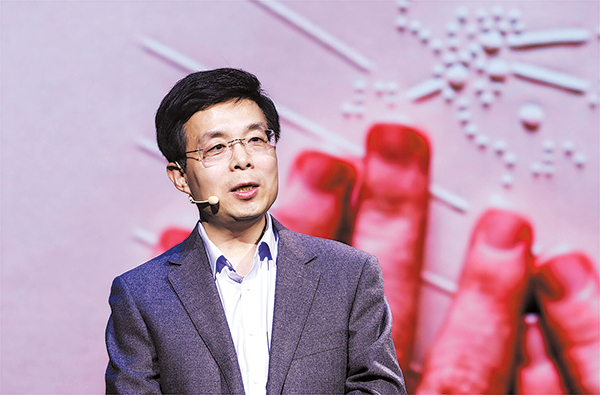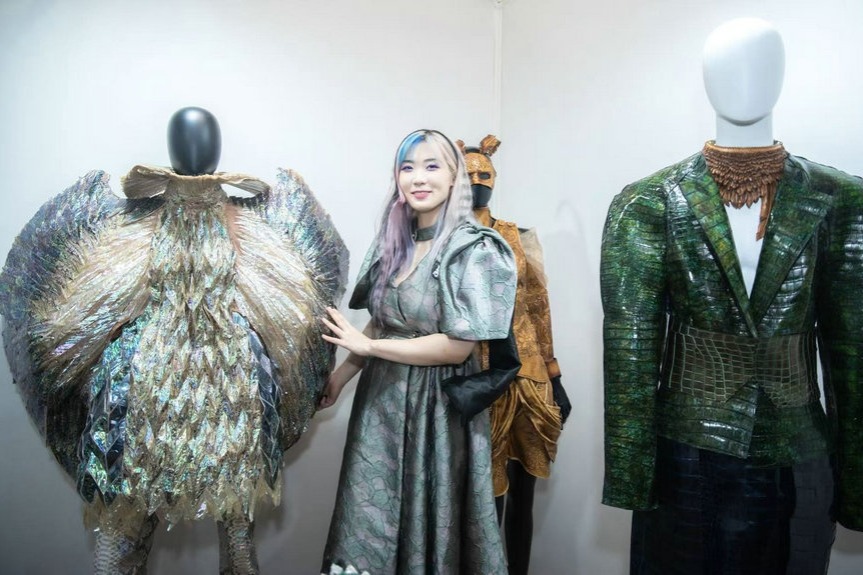Innovations focus on overcoming challenges


"Visually impaired children have to be really cautious when touching the dots of a traditional Braille book," says Song Yanlin, a professor at the Institute of Chemistry, Chinese Academy of Sciences.
While Braille can only be imprinted on specially imported paper, which costs 15 to 20 times more than regular paper, the raised dots within Braille books can easily become flattened with repeated reading. The high expense and scarcity of Braille books can hinder educational opportunities for visually impaired children.
Recognizing the urgent need for innovation in Braille printing technology, Song and his team embarked on a mission to enhance the quality and efficiency of Braille printing. Their research subsequently helped revolutionize Braille printing and improved printing accuracy at multiple levels.
The new Braille printing technology has been promoted in China to the forefront in the field of global green Braille printing.
Investing in the future
A traditional Braille printer embosses dots onto a special kraft paper using metal plates, but books printed using this method may not be durable. Song suggested transforming the conventional Braille printing process to make it more accessible.
"By precisely controlling the formation of ink droplets and manipulating each droplet to create a slightly raised structure, a basic Braille character can be represented," Song says.
The primary hurdle for Song and his team was in tackling the "coffeering effect", a persistent issue in the field of printing in which a liquid, like a drop of coffee, evaporates on a surface, resulting in a ring-like pattern.
Since 2006, Song and his team have concentrated on studying the coffee-ring effect in inkjet printing. They effectively managed nanoscale interface properties between the ink and substrate, averting any unexpected spreading of ink droplets.
Based on this breakthrough, they printed the smallest ink dots recorded, with each containing just a few nanoparticles. These dots were interconnected to produce the finest lines, then the sleekest surfaces.
The achievement marks a leap beyond traditional six-dot printing in Braille. With this new printing technology, Braille is not confined to text alone. It can also generate intricate graphics, aiding visually impaired students in comprehending complex mathematical concepts.
"By achieving this, blind children can also experience the beautiful curves of mathematical functions, appreciate three-dimensional topographical maps, and enjoy the pleasure brought by graphics and patterns through the touch of their fingertips," he says.
Researchers also used environmentally friendly nano-antibacterial ink on 3D materials.
"This material permeates the surface of the paper, deeply integrating with the paper fibers through capillary force. It can firmly bond with the paper surface, so Braille dots will be highly resistant to friction, ensuring the durability of Braille books," Song says.
In addition to printing on paper, the new technology facilitates printing on a variety of other materials. Song crafted a specialized Rubik's Cube for the visually impaired, featuring distinct patterns on each face. The technology has the potential to be incorporated into the daily life and needs of the visually impaired, such as in the design of packaging and bags, Song says.
During a visit to the Beijing School for the Blind, Song found that a number of visually impaired children exhibited exceptional proficiency in solving Rubik's Cube puzzles, often surpassing other children in both speed and skill.
"Blind children are born without intellectual difference compared with sighted children. However, the disparity widens due to limitations in their educational opportunities," Song says.
"Our goal is to bridge this gap. We aim to enrich the cultural experiences of those unable to perceive the world through their eyes."
The Braille printing technology was adopted during the 2022 Beijing Winter Olympics and Paralympics. The team printed bilingual books to include visually impaired audiences. It covered athlete guides, venue descriptions, real-time event updates, and extensive tactile maps placed around event locations.
"It marked a historic moment in the Olympics as it represents the first widespread use of inclusive materials catering to both sighted and visually impaired audiences," Song says.
Dedicated to others
The innovative technology has been adopted in various settings across China, with the first few batches of tactile postcards and maps specifically designed for the visually impaired having been introduced in museums and libraries in Nanjing and Fuzhou of Jiangsu and Fujian provinces.
At the Beijing Daxing International Airport, Song and his team's research was represented through tactile signage that helped visually impaired travelers get around and significantly enhanced the airport's accessibility services.
To further improve the reading experiences of the visually impaired, Song developed multisensory printing products.
"Relying solely on touch significantly limits the information available to people with visual impairments. By integrating auditory and olfactory elements into the ink, our aim is to provide them with a comprehensive sensory experience," he says.
Utilizing the new technology, people can print a Braille book where, upon a visually impaired person touching objects like an apple or a pear in the picture book, they can also experience the genuine scents of the corresponding fruits. The innovation is set to significantly compensate for the lack of visual input.
"We aspire to extend these benefits to blind individuals worldwide," Song says.
He is actively exploring potential collaborations with international disability support organizations and Braille printing houses to share the technology and enhance the lives of visually impaired people globally.
About a decade ago, Song had an encounter with a young visually impaired girl who was singing You Are My Bright Eyes, originally performed by a visually impaired singer named Xiao Huangqi.
"I was deeply touched by the lyrics and the girl's performance," Song says.
From that moment on, a seed was planted in his heart.
"I started to think how we could help improve the lives of the blind by scientific research, and I found a field that requires more attention, that is, Braille printing," he says.
Song says what he does is "a journey of mutual enlightenment".
He once visited a school for the visually impaired and, enjoying a children's choir, felt his soul purified. "Their faces were pure and innocent, which was testament to their incredibly resilient and strong spirit despite disabilities," he says. "If we can embrace such positive attitudes toward life, we can find joy too."
Song says he believes that scientific research should be motivated by the needs of society.
Song and his team have begun experiments to develop and print high-performance, resilient cochlear implants for those with hearing disabilities, as well as innovative facial expression recognition systems for individuals unable to speak. The research is still in the experimental stage.
"It's vital to concentrate on the less noticeable areas, to attend to what others might overlook," he says.



































